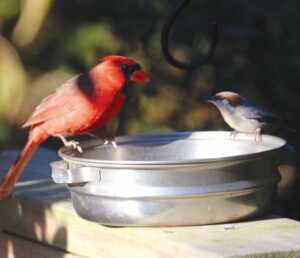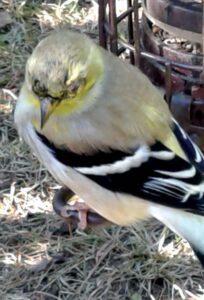Since 1987, classrooms, homeowners, nature centers, and birders have been counting the birds for science via Project FeederWatch (PFW), a joint initiative between Cornell Lab of Ornithology and Birds Canada. PFW engages individuals, classrooms, families, and other groups across North America in establishing bird feeding areas on property to observe the behavior and biology of birds in winter from November 1 through April 30—six months of data collection.
Scientists use the data to identify and track bird diseases and the spread of diseases. House finch eye disease was discovered during PFW.
PFW data can also help with these questions. How does weather and climate change influence bird populations? What differences in bird diversity are in cities vs. suburban or rural vs. natural areas? Which vegetation do birds forage on?
I noticed yellow-rumped warblers headed for the wax myrtle berries. Soon the white-throated sparrows will return to forage on the ground for seeds and berries. Bluebirds, brown thrashers, cardinals, and mockingbirds love dogwood berries. Tufted titmice and Carolina chickadees peck open the seedpods on redbuds.
Persimmons are a favorite food for catbirds, cedar waxwings, mockingbirds, robins, and wild turkey.
A recent U.S. National Science Foundation grant expanded PFW data collection to include observations of mammals (e.g. deer, fox, mice, rabbits, squirrels, dogs, cats, etc.) visiting bird-feeding areas.
At the end of each PFW season, Cornell Lab and Birds Canada tabulate the 2024-2025 data and report back to participants via Winter Bird Highlights. feederwatch.org/explore/year-end-reports/
I received the Southeast Region report, which includes data from 2,348 sites in South Carolina, Georgia, Alabama, Mississippi, Louisiana, and Texas and will be distributing the report to a Project Feeder- Watch workshop on November 1 at Wild Birds Unlimited in the Village at Sandhill. The top ten birds sited by southeastern feeder watchers were Northern Cardinal, Carolina Chickadee, Carolina Wren, House Finch, Mourning Dove, Tufted Titmouse, Blue Jay, Red-bellied Woodpecker, Downy Woodpecker, and American Goldfinch. Scientists have reported the American Goldfinch population is on decline and are unsure as to why. I have noticed goldfinches do get finch eye disease, which limits their ability to see, find food, fly, and escape predation.
PFW participation costs $18 per year and is paid on an annual basis. Counts are made on two consecutive days with five days between counts. Time to count can be as little as 15 minutes or as much as eight hours. Participants joining PFW receive a calendar poster with about 42 birds identified plus a set of instructions on choosing the count site, count days, how long to count, what to count, how to count, and reporting your counts. Data counted is reported on the PFW website at feederwatch.org/about.
It’s not too late to join PFW for the 2025-26 season or to join the flock at Wild Birds Unlimited in the Village at Sandhill, November 1 at 2 p.m. for more information. Reserve a seat by calling 803-736-4810.






Loading Comments